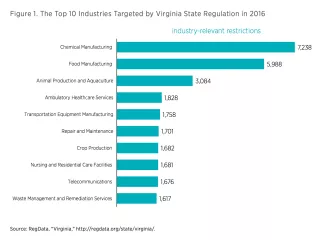- | Housing Housing
- | Expert Commentary Expert Commentary
- |
How Virginia Can Save Money and Cut Red Tape at the Same Time
A more formal way to change agency incentives is by imposing a regulatory budget, which places a cap on overall regulatory burdens, and the simplest regulatory budget would phase out two, three, or four requirements for each new one introduced. A regulatory budget gives agencies some political cover to eliminate rules without having to publicly acknowledge failure.
Earlier this year, Richmond appeared to be following the lead of Washington, D.C., and several other states by putting outdated regulations in the crosshairs.
The General Assembly put forward House Bill 1564 — dubbed the “Red Tape Reduction Act” — seeking to reduce regulation in the commonwealth by an ambitious 35 percent. The effort was deemed too expensive, but there are some ways to tackle the problem that won’t cost Virginia taxpayers.
In 2016, the Virginia Administrative Code contained over 8.8 million words and more than 133,000 restrictive words (such as “shall,” “must” and “may not”). When combined with the more than 1 million restrictive words in the federal code, it’s hard to imagine all this complexity not having a chilling effect on Virginia businesses, and more importantly, on growth and innovation.
Perhaps not coincidentally, growth in the state seems to be lagging the rest of the nation. From 2005 to 2015, per capita personal incomes grew by 2.6 percent annually, while the national average was 3.0 percent. Economic growth averaged 0.9 percent per year in Virginia during this period, while the corresponding rate for the nation was 1.3 percent. Seemingly minor differences like these lead to big differences in outcomes for citizens over time.
The stalled bill would have established a new Red Tape Reduction Commission to review the state’s regulatory requirements and charged a new Division of Regulatory Management with measuring the state’s initial level of regulation. Five new state employees would have been required — at a cost of $700,000 annually, which was apparently too much for the state budget.
While $700,000 is not a trivial expense, eliminating regulatory burdens has the potential to save the state economy millions. Since budget concerns should be taken seriously, how can regulatory reforms be implemented without adding many — or even any — additional budget outlays?
First, look to an existing regulatory body to oversee the effort. Virginia has an Economic and Regulatory Analysis Division within the Virginia Department of Planning and Budget. These types of agencies already have considerable experience with the state’s regulatory process, so they can hit the ground running.
Another option is for state agencies to do much of the heavy lifting themselves. After all, regulators have some sense of which rules are working and which are not. The problem with this approach is that agency employees may feel personally attacked when reformers seek to eliminate the very rules regulators spent years writing and enforcing. Reform efforts often meet heavy resistance for this reason.
This is why changing the incentives of the agencies is critical. It’s not enough to just tell them to reduce burdens and hope for the best. A well-known, charismatic leader for the effort can generate public support and buy-in from agencies by explaining in clear terms the benefits of regulatory reform, such as improving economic growth and making government more efficient.
A more formal way to change agency incentives is by imposing a regulatory budget, which places a cap on overall regulatory burdens. In other places where this has been done, such as the Canadian province of British Columbia, agency rule-writers became rule managers who tracked the progress of rules over time and modified or eliminated ineffective ones along the way.
A regulatory budget also gives the agencies some political cover to eliminate rules without having to publicly acknowledge failure. And it gives them the authority to use their expertise to say which rules stay and which ones go.
Perhaps the simplest regulatory budget would phase out two, three, or four requirements for each new one introduced. President Trump recently put in place something similar in the federal government.
There are good reasons to believe reforms like these could greatly benefit Virginia’s economy, and each can be implemented at little-to-no cost. Slow growth was a key motivation behind the Red Tape Reduction Act, but for the moment it looks like the effort is on hold. It will be important to watch what happens in the months and years ahead.
